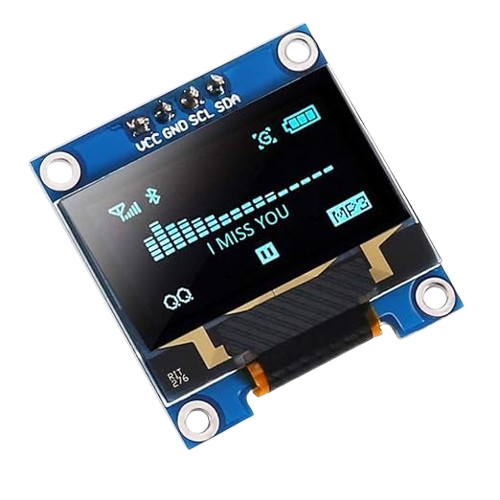OLED Display in IoT: Features, Types, Interfacing, and Real-World Applications
Explore how OLED displays are transforming IoT projects with their compact size, low power consumption, and high clarity. Learn about types of OLEDs, interfacing methods with Arduino or ESP32, and practical use cases in smart devices. A complete guide for electronics hobbyists and developers building smarter embedded systems.

Device Overview
What is an OLED Display?
OLED (Organic Light Emitting Diode) is an advanced display technology that uses organic compounds to emit light when electrically powered. Unlike traditional LCDs, OLED displays do not require a backlight, making them clearer, thinner, lighter, and more power-efficient. Due to these advantages, OLEDs are widely used in IoT (Internet of Things) devices for displaying data on compact screens.
How Does an OLED Display Work?
OLEDs consist of several layers including a cathode, organic emissive and conductive layers, and an anode. When electric current passes through these layers, electrons and holes recombine in the organic layer, producing light at each pixel. This self-emitting property eliminates the need for a backlight, enabling better contrast and deeper blacks.
Key Features of OLED Displays for IoT Applications
-
Compact Size: Common sizes are 0.96", 1.3", and 1.5", ideal for small IoT modules.
-
Low Power Consumption: Since no backlight is needed, OLEDs are perfect for battery-powered IoT devices.
-
High Contrast & Sharp Text: Each pixel emits its own light, resulting in excellent contrast and readability.
-
Flexible Display Options: Some OLEDs offer bendable or flexible screens, suitable for wearable IoT gadgets.
-
Easy Interface: Supports popular protocols like I2C and SPI for simple microcontroller integration (Arduino, ESP32).
-
Wide Viewing Angle: Ensures clear visibility from different directions, important for embedded applications.
Types of OLED Displays Based on Technology and Interface
| Type | Description | Typical Use Case |
|---|---|---|
| Passive Matrix OLED (PMOLED) | Simple control, fewer pixels, cost-effective | Wearables, battery-powered devices |
| Active Matrix OLED (AMOLED) | Advanced, high refresh rates | Smartphones, premium IoT devices |
| Monochrome OLED | Single color (white, blue, yellow) | Sensor readouts, status displays |
| Color OLED | Multi-color text and graphics | Interactive dashboards, smart meters |
| I2C OLED Display | 4 pins (VCC, GND, SDA, SCL), easy wiring | Arduino and ESP32 projects |
| SPI OLED Display | Faster data transfer, more pins | Real-time sensor data displays |
Common OLED Module Specifications for IoT
| Parameter | Details |
|---|---|
| Size | Typically 0.96 inch (128x64 or 128x32 pixels) |
| Interface | I2C or SPI |
| Voltage | 3.3V to 5V |
| Controller IC | SSD1306 or SH1106 |
| Display Color | Monochrome (White/Blue/Yellow) or RGB Color |
| Popular Libraries | Adafruit SSD1306, U8g2 |
Popular OLED Controller ICs Used in IoT
-
SSD1306: Monochrome, 128x64 or 128x32 resolution, supports I2C and SPI; most common in Arduino/ESP projects.
-
SH1106: Similar to SSD1306 but with more memory; used in advanced I2C OLED modules.
-
SSD1331: Full-color RGB OLED, SPI interface; for color OLED displays.
-
SSD1351: Higher performance RGB controller used in premium displays.
How to Interface an OLED Display with Arduino/ESP32
Components Needed:
- Arduino UNO or ESP32 board
- 0.96" I2C OLED Display (SSD1306)
- Jumper wires
- Arduino IDE software
Circuit Connections (I2C OLED):
| OLED Pin | Arduino UNO Pin | ESP32 Pin |
|---|---|---|
| VCC | 5V | 3.3V |
| GND | GND | GND |
| SDA | A4 | GPIO 21 |
| SCL | A5 | GPIO 22 |
Sample Arduino Code for OLED Display (SSD1306)
Real-World Applications of OLED Displays in IoT
- Smart Home Systems: Displaying temperature, humidity, and security alerts
- Wearable Devices: Fitness trackers, smartwatches with flexible screens
- Sensor Monitoring: Live sensor data visualization on compact displays
- Agriculture IoT: Soil moisture and irrigation pump status
- Battery-Powered Projects: Long-lasting display due to low power usage
- Energy Meters: Showing consumption and alerts in real-time
- Clocks & Timers: Embedded real-time clocks for automation
Why Choose OLED over LCD for IoT?
| OLED | LCD |
|---|---|
| Self-light emitting pixels | Requires backlight |
| Superior contrast and viewing angles | Limited viewing angles |
| More power efficient | Higher power consumption |
| Slim and lightweight | Bulkier design |
| Available in flexible formats | Generally rigid |
Limitations of OLED Displays
-
Limited Lifespan: Blue OLED pixels last about 14,000 to 20,000 hours, but sufficient for typical IoT use.
-
Higher Cost: OLED modules are somewhat costlier than LCDs, justified by better performance.
-
Outdoor Visibility: Reduced readability under direct sunlight compared to LCD.
Buying Guide for OLED Displays in IoT
-
Voltage Compatibility: Ensure 3.3V or 5V support based on your microcontroller.
-
Interface Type: Use I2C for simpler wiring; SPI for faster data transfer needs.
-
Controller Chip: SSD1306 is beginner-friendly and widely supported.
-
Library Support: Confirm availability of libraries like Adafruit SSD1306 or U8g2 for ease of programming.
-
Screen Size: 0.96 inch displays are popular and adequate for most IoT projects.
Where to Buy
| Platform | Price | Action |
|---|---|---|
|
|
₹365 | Buy Now |
Prices may vary. Click on "Buy Now" to check current availability and pricing.
Administrator
Frequently Asked Questions
Common questions about OLED Display in IoT: Features, Types, Interfacing, and Real-World Applications. Find answers to the most frequently asked questions.
User Reviews & Comments
Share your experience with this IoT device. Your feedback helps our community make informed decisions!
Share Your Experience
Help others by sharing your thoughts about this IoT device.
Related Devices
Explore more IoT devices in the same category
No Related Devices
Check out other categories for more IoT devices.
No Reviews Yet
Be the first to share your experience with this IoT device!